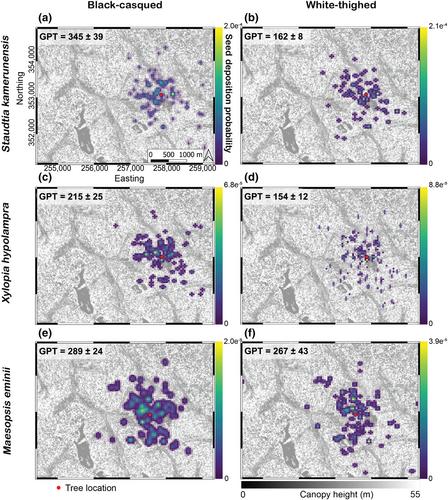Three-dimensional vegetation structure drives patterns of seed dispersal by African hornbills
IF 3.5
1区 环境科学与生态学
Q1 ECOLOGY
引用次数: 0
Abstract

三维植被结构驱动非洲犀鸟传播种子的模式。
三维植被结构会影响动物的活动,进而影响生态系统的功能。热带雨林是地球上结构最复杂的生态系统之一,在热带雨林中,60%-90%的树木种子都是由动物传播的。在这里,我们研究了三维雨林结构如何影响大型食草鸟类的运动以及由此产生的种子传播空间模式。我们在喀麦隆南部利用光探测和测距(LiDAR)技术调查的一个研究区域内对白腰犀鸟(Bycanistes albotibialis)和黑腹犀鸟(Ceratogymna atrata)进行了 GPS 跟踪。我们发现,这两种犀鸟都喜欢树冠高度较高的区域,而白腹犀鸟则喜欢垂直复杂度较高的区域。此外,33%的犀鸟喜欢靠近树冠间隙的区域,而分别有16.7%和27.8%的犀鸟避开大的和小的间隙。白腰犀鸟避开沼泽栖息地,而黑冠犀鸟在气温最热的时候则更喜欢沼泽。我们绘制了犀鸟传播种子的空间概率图,表明三维结构属性通过影响犀鸟的行为塑造了这一生态过程。这些结果为雨林植被结构与动物种子传播之间可能存在的反馈回路提供了证据。这里描述的种子传播者与植被结构之间的相互作用对于了解热带雨林的生态系统功能至关重要,对于预测雨林如何应对人为影响也至关重要。
本文章由计算机程序翻译,如有差异,请以英文原文为准。
求助全文
约1分钟内获得全文
求助全文
来源期刊

Journal of Animal Ecology
环境科学-动物学
CiteScore
9.10
自引率
4.20%
发文量
188
审稿时长
3 months
期刊介绍:
Journal of Animal Ecology publishes the best original research on all aspects of animal ecology, ranging from the molecular to the ecosystem level. These may be field, laboratory and theoretical studies utilising terrestrial, freshwater or marine systems.
 求助内容:
求助内容: 应助结果提醒方式:
应助结果提醒方式:


